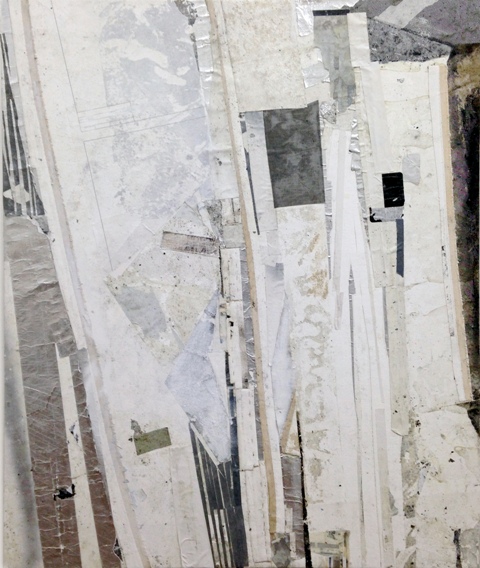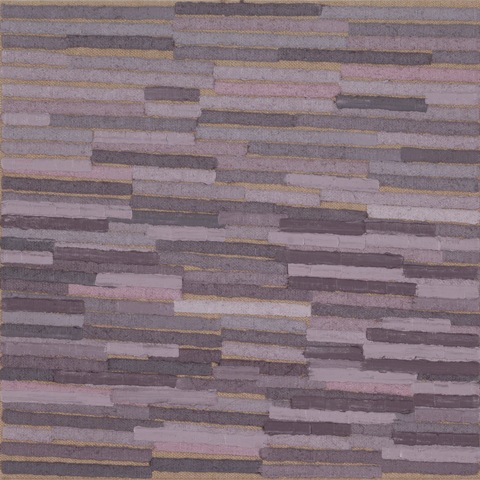Tempting as it is to believe—or perhaps to dream—that the first iteration of a work of art can be the complete and final fulfillment of a single burst of creativity, the historical record and our own often painful experience combine to demonstrate that this is almost never the case. In the visual arts as well as in all forms of writing and in music, the original idea or vision may go through anywhere from several up to hundreds of revisions before the artist deems the work completed.
For Janet Goleas, the curator of the new “Redacted” exhibition that opened on April 13, 2014 at the Islip Art Museum, one of the most interesting questions raised by the inevitable changes made to an artwork is to what degree those changes alter, obscure or enhance the original creative vision and intention.
The group exhibition features selected paintings, drawings, sculpture, collage and assemblage by artists Josh Blackwell, Sharon Butler, Jonathan Callan, Eric Dever, Stacy Fisher, Brian Gaman, Jim Lee, Lauren Luloff, Stefana McClure, Linda Miller, Bonnie Rychlak, Mathias Schmeid, Tim Spelios, Ryan Steadman, Ryan Wallace, Ross Watts and Letha Wilson.
A reception for the artists to be held on Sunday, May 4, 2014 from 1 to 4 p.m. is free and open to the public. The exhibition will run through June 1, 2014. The museum will be closed from April 17 to 25, 2014.
The works on view were selected by Goleas for an examination of alterations, inversions, erasures, cover-ups, cut-aways, strike-throughs and other amendments in vision, thought and execution by contemporary artists working in a variety of mediums and methodologies.
In discussing the theme for the show in an exhibition release, Goleas points out that while the Oxford English Dictionary defines redact as meaning “to edit,” the term took on a broader depth of meaning in the 20th century, with myriad connotations of “obfuscation, disinformation, censorship and the almighty non-sequitur.”
The discussion, which amounts to a sort of mini catalog essay, suggests that “deletion or disinformation—redactions—in nonfiction can have the effect of turning truth into fantasy. Excision or concealment in written, auditory, or film and video material might alter history, obscure entire hypotheses or convert, disguise or transform content. In the visual brain, imagery can be eclipsed by ocular migraines or sun blindness resulting in a redacted visual field, and in psychology, trauma can result in whole areas of memory ceasing to be accessible. But since 1953, when Robert Rauschenberg spent that long month erasing one of Willem de Kooning’s favorite drawings, the idea of redaction has been central to the concept of altered content in visual art.”
“Inherently political, the act of erasing, transmuting or removing content is something that comes naturally to the visual artist,” the curator continues, “—one might even posit that it is an inevitable part of the creative process.”
Goleas also connects ideas about redacting to the artists selected for the exhibition:
“For Josh Blackwell,” she writes, “the ubiquitous plastic bag becomes a transformative, fetishized object—a repository upon which the artist’s mark-making converts our cultural scraps into sumptuous fields of ornament and visual invention. In works by Sharon Butler, Jim Lee and Lauren Luloff, whole areas of observed information are excised from view, yet they anchor the visual field both in composition and ideology.”
Addressing the other artists in the exhibition, Goleas writes:
“Eric Dever abridges color and form to minimalist equations in reductive suites of serial paintings, while Linda Miller, Bonnie Rychlak and Stacy Fisher examine the presence/absence of negative vs. positive space in evocative works that question corporeality, identity and presence. In Letha Wilson’s complex portraits of the American West, idioms collide, placing the iconic natural landscape alongside industrialization and fractured content.”
.
.
“Collages by Tim Spelios reorder the history of art and its context and Ryan Steadman’s ersatz book forms provide a beguiling and painterly façade in which the viewer really can tell a book by its cover. For Ryan Wallace, the vestiges of earlier works assemble like DNA strands, forging a wholly new but relational family of paintings.”
.

"Redactor 2.14 II" by Ryan Wallace, 2014. Enamel, acrylic, powdered graphite, cold wax, vinyl, aluminum, tape, paper, Mylar, canvas on canvas, 58 x 48 inches.
.
“Jonathan Callan, Stefana McClure and Ross Watts mine the written word, conferring aesthetic interdictions upon works of literature as well as the syntax of this century’s information overload. Mathias Schmeid delicately transforms visual data, morphing graphic imagery into ephemeral sculptural anatomies. For Brian Gaman, the visual field is so deeply in focus that sight itself is recalibrated to the infinite.”
Janet Goleas is an artist, writer and curator who writes regularly for her art blog, blinnk, and for HamptonsArtHub.com. She is based in East Hampton, NY. She is also the founder and chief curator for The Moby Project.
BASIC FACTS: “Redacted” will be exhibited from April 13 to June 1 at the Islip Art Museum. The museum will be closed from April 17 to 25. An Artists Reception will be held on May 4 from 1 to 4 p.m. The museum is located at 50 Irish Lane, East Islip, NY 11730. www.islipartmuseum.org.
__________________
Copyright 2014 Hamptons Art Hub LLC. All rights reserved.

